Color Change of Phenol Red by Integrated Smart Phone Camera as a Tool for the Determination of Neurotoxic Compounds
Abstract
:1. Introduction
2. Experimental Section
2.1. Materials and Instruments
2.2. Preparation of Gelatin with Immobilized AChE
2.3. Solutions Preparation
2.4. Measuring Process
2.5. Ellman’s Assay
2.6. Data Processing
3. Results and Discussion
4. Conclusions
Acknowledgments
Author Contributions
Conflicts of Interest
References
- Soreq, H.; Seidman, S. Acetylcholinesterase—New roles for an old actor. Nat. Rev. Neurosci. 2001, 2, 294–302. [Google Scholar] [CrossRef] [PubMed]
- Pohanka, M. Butyrylcholinesterase as a biochemical marker. Bratisl. Lek. Listy 2012, 114, 726–734. [Google Scholar] [CrossRef]
- Pohanka, M. Cholinesterase, a target of pharmacology and toxicology. Biomed. Pap. 2011, 155, 219–223. [Google Scholar] [CrossRef] [PubMed]
- Pohanka, M. Biosensors based on cholinesterases. Chem. Listy 2013, 107, 121–125. [Google Scholar]
- Pohanka, M. Biosensors containing acetylcholinesterase and butyrylcholinesterase as recognition tools for detection of various compounds. Chem. Pap. 2015, 69, 4–16. [Google Scholar] [CrossRef]
- Worek, F.; Mast, U.; Kiderlen, D.; Diepold, C.; Eyer, P. Improved determination of acetylcholinesterase activity in human whole blood. Clin. Chim. Acta 1999, 288, 73–90. [Google Scholar] [CrossRef]
- Kostelnik, A.; Cegan, A.; Pohanka, M. Electrochemical determination of activity of acetylcholinesterase immobilized on magnetic particles. Int. J. Electrochem. Sci. 2016, 11, 4840–4849. [Google Scholar] [CrossRef]
- Pohanka, M. Voltammetric assay of butyrylcholinesterase in plasma samples and its comparison to the standard spectrophotometric test. Talanta 2014, 119, 412–416. [Google Scholar] [CrossRef] [PubMed]
- Morís-Varas, F.; Shah, A.; Aikens, J.; Nadkarni, N.P.; Rozzell, J.D.; Demirjian, D.C. Visualization of enzyme-catalyzed reactions using ph indicators: Rapid screening of hydrolase libraries and estimation of the enantioselectivity. Bioorg. Med. Chem. 1999, 7, 2183–2188. [Google Scholar] [CrossRef]
- Munjal, N.; Sawhney, S.K. Stability and properties of mushroom tyrosinase entrapped in alginate, polyacrylamide and gelatin gels. Enzyme Microb. Technol. 2002, 30, 613–619. [Google Scholar] [CrossRef]
- Mogharabi, M.; Nassiri-Koopaei, N.; Bozorgi-Koushalshahi, M.; Nafissi-Varcheh, N.; Bagherzadeh, G.; Faramarzi, M.A. Immobilization of laccase in alginate-gelatin mixed gel and decolorization of synthetic dyes. Bioinorg. Chem. Appl. 2012, 2012, 823830. [Google Scholar] [CrossRef] [PubMed]
- Tanriseven, A.; Doğan, Ş. A novel method for the immobilization of β-galactosidase. Process Biochem. 2002, 38, 27–30. [Google Scholar] [CrossRef]
- Bigi, A.; Cojazzi, G.; Panzavolta, S.; Rubini, K.; Roveri, N. Mechanical and thermal properties of gelatin films at different degrees of glutaraldehyde crosslinking. Biomaterials 2001, 22, 763–768. [Google Scholar] [CrossRef]
- Zheng, Y.; Liu, Z.; Jing, Y.; Li, J.; Zhan, H. An acetylcholinesterase biosensor based on ionic liquid functionalized graphene-gelatin-modified electrode for sensitive detection of pesticides. Sens. Actuators B Chem. 2015, 210, 389–397. [Google Scholar] [CrossRef]
- García, A.; Erenas, M.M.; Marinetto, E.D.; Abad, C.A.; de Orbe-Paya, I.; Palma, A.J.; Capitán-Vallvey, L.F. Mobile phone platform as portable chemical analyzer. Sens. Actuators B Chem. 2011, 156, 350–359. [Google Scholar] [CrossRef]
- Pohanka, M. Photography by cameras integrated in smartphones as a tool for analytical chemistry represented by an butyrylcholinesterase activity assay. Sensors 2015, 15, 13752–13762. [Google Scholar] [CrossRef] [PubMed]
- Petryayeva, E.; Algar, W.R. Multiplexed homogeneous assays of proteolytic activity using a smartphone and quantum dots. Anal. Chem. 2014, 86, 3195–3202. [Google Scholar] [CrossRef] [PubMed]
- Meier, R.J.; Schreml, S.; Wang, X.-D.; Landthaler, M.; Babilas, P.; Wolfbeis, O.S. Simultaneous photographing of oxygen and pH in vivo using sensor films. Angew. Chemie Int. Ed. 2011, 50, 10893–10896. [Google Scholar] [CrossRef] [PubMed]
- Grudpan, K.; Kolev, S.D.; Lapanantnopakhun, S.; McKelvie, I.D.; Wongwilai, W. Applications of everyday it and communications devices in modern analytical chemistry: A review. Talanta 2015, 136, 84–94. [Google Scholar] [CrossRef] [PubMed]
- Lourenço, N.M.T.; Österreicher, J.; Vidinha, P.; Barreiros, S.; Afonso, C.A.M.; Cabral, J.M.S.; Fonseca, L.P. Effect of gelatin-ionic liquid functional polymers on glucose oxidase and horseradish peroxidase kinetics. React. Funct. Polym. 2011, 71, 489–495. [Google Scholar] [CrossRef]
- Zhu, H.; Sikora, U.; Ozcan, A. Quantum dot enabled detection of Escherichia coli using a cell-phone. Analyst 2012, 137, 2541–2544. [Google Scholar] [CrossRef] [PubMed]
- Bwambok, D.K.; Christodouleas, D.C.; Morin, S.A.; Lange, H.; Phillips, S.T.; Whitesides, G.M. Adaptive use of bubble wrap for storing liquid samples and performing analytical assays. Anal. Chem. 2014, 86, 7478–7485. [Google Scholar] [CrossRef] [PubMed]
- Lu, Y.; Shi, W.; Qin, J.; Lin, B. Low cost, portable detection of gold nanoparticle-labeled microfluidic immunoassay with camera cell phone. Electrophoresis 2009, 30, 579–582. [Google Scholar] [CrossRef] [PubMed]
- Su, L.; Feng, J.; Zhou, X.; Ren, C.; Li, H.; Chen, X. Colorimetric detection of urine glucose based ZnFe2O4 magnetic nanoparticles. Anal. Chem. 2012, 84, 5753–5758. [Google Scholar] [CrossRef] [PubMed]
- Kanjanawarut, R.; Su, X. Colorimetric detection of DNA using unmodified metallic nanoparticles and peptide nucleic acid probes. Anal. Chem. 2009, 81, 6122–6129. [Google Scholar] [CrossRef] [PubMed]
- Shen, L.; Hagen, J.A.; Papautsky, I. Point-of-care colorimetric detection with a smartphone. Lab Chip 2012, 12, 4240–4243. [Google Scholar] [CrossRef] [PubMed]
- Jokerst, J.C.; Adkins, J.A.; Bisha, B.; Mentele, M.M.; Goodridge, L.D.; Henry, C.S. Development of a paper-based analytical device for colorimetric detection of select foodborne pathogens. Anal. Chem. 2012, 84, 2900–2907. [Google Scholar] [CrossRef] [PubMed]
- Timur, S.; Telefoncu, A. Acetylcholinesterase (AChE) electrodes based on gelatin and chitosan matrices for the pesticide detection. Artif. Cells Blood Substit. Biotechnol. 2004, 32, 427–442. [Google Scholar] [CrossRef]
- Pohanka, M.; Fusek, J.; Adam, V.; Kizek, R. Carbofuran assay using gelatin based biosensor with acetylcholinesterase as a recogniton element. Int. J. Electrochem. Sci. 2013, 8, 71–79. [Google Scholar]
- Pohanka, M. Inhibitors of acetylcholinesterase and butyrylcholinesterase meet immunity. Int. J. Mol. Sci. 2014, 15, 9809–9825. [Google Scholar] [CrossRef] [PubMed]
- Hynes, W.F.; Doty, N.J.; Zarembinski, T.I.; Schwartz, M.P.; Toepke, M.W.; Murphy, W.L.; Atzet, S.K.; Clark, R.; Melendez, J.A.; Cady, N.C. Micropatterning of 3D microenvironments for living biosensor applications. Biosensors 2014, 4, 28–44. [Google Scholar] [CrossRef] [PubMed]
- Pohanka, M. Cholinesterases in biorecognition and biosensor construction, a review. Anal. Lett. 2013, 12, 1849–1868. [Google Scholar] [CrossRef]
- Pohanka, M.; Vlcek, V. Preparation and performance of a colorimetric biosensor using acetylcholinesterase and indoxylacetate for assay of nerve agents and drugs. Int. Toxicol. 2014, 7, 215–218. [Google Scholar] [CrossRef] [PubMed]
- Liston, D.R.; Nielsen, J.A.; Villalobos, A.; Chapin, D.; Jones, S.B.; Hubbard, S.T.; Shalaby, I.A.; Ramirez, A.; Nason, D.; White, W.F. Pharmacology of selective acetylcholinesterase inhibitors: Implications for use in alzheimer’s disease. Eur. J. Pharmacol. 2004, 486, 9–17. [Google Scholar] [CrossRef] [PubMed]
- Di Giovanni, S.; Borloz, A.; Urbain, A.; Marston, A.; Hostettmann, K.; Carrupt, P.-A.; Reist, M. In vitro screening assays to identify natural or synthetic acetylcholinesterase inhibitors: Thin layer chromatography versus microplate methods. Eur. J. Pharmacol. 2008, 33, 109–119. [Google Scholar] [CrossRef] [PubMed]
- Wiedmer, T.; di Francesco, C.; Brodbeck, U. Effects of amphiphiles on structure and activity of human erythrocyte membrane acetylcholinesterase. Eur. J. Pharm. Sci. 1979, 102, 59–64. [Google Scholar] [CrossRef]
- Pohanka, M. Acetylcholinesterase based dipsticks with indoxylacetate as a substrate for assay of organophosphates and carbamates. Anal. Lett. 2012, 45, 367–374. [Google Scholar] [CrossRef]
- Rhee, I.K.; Appels, N.; Luijendijk, T.; Irth, H.; Verpoorte, R. Determining acetylcholinesterase inhibitory activity in plant extracts using a fluorimetric flow assay. Phytochem. Anal. 2003, 14, 145–149. [Google Scholar] [CrossRef] [PubMed]
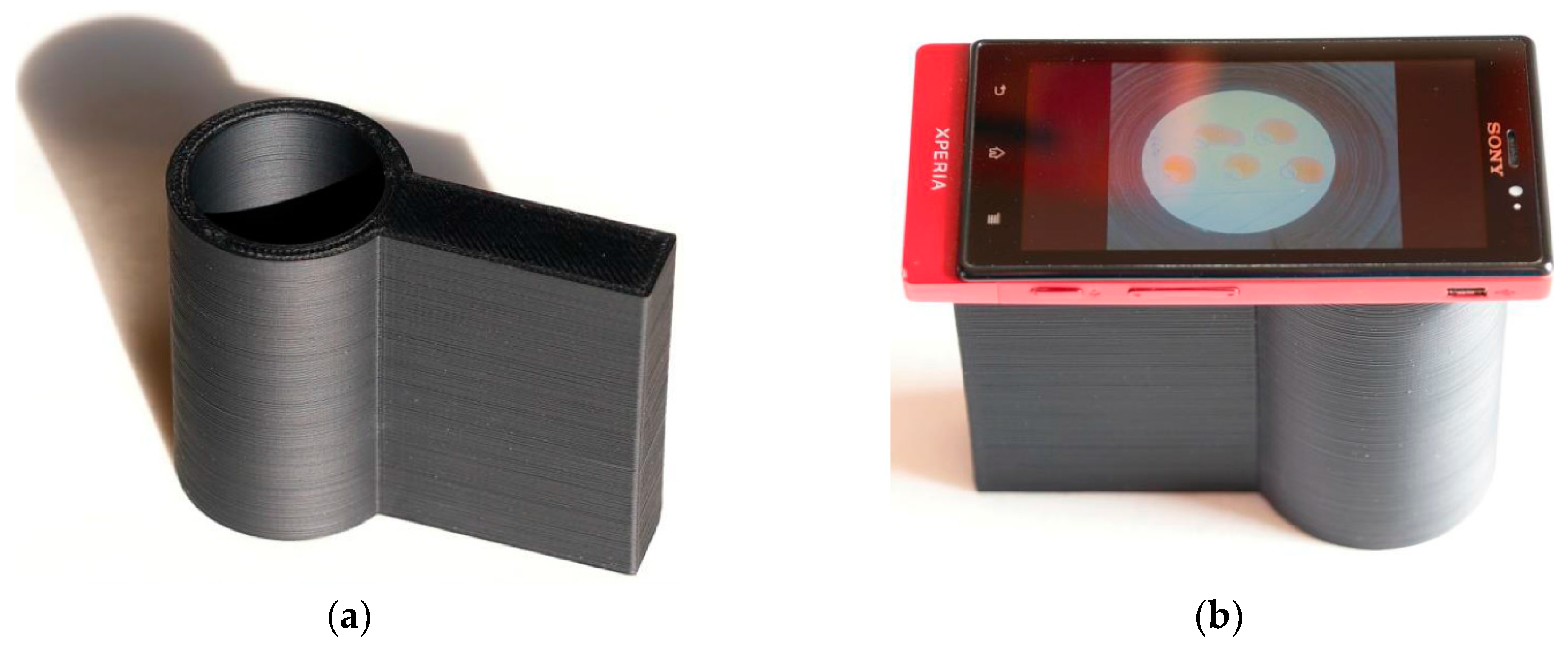

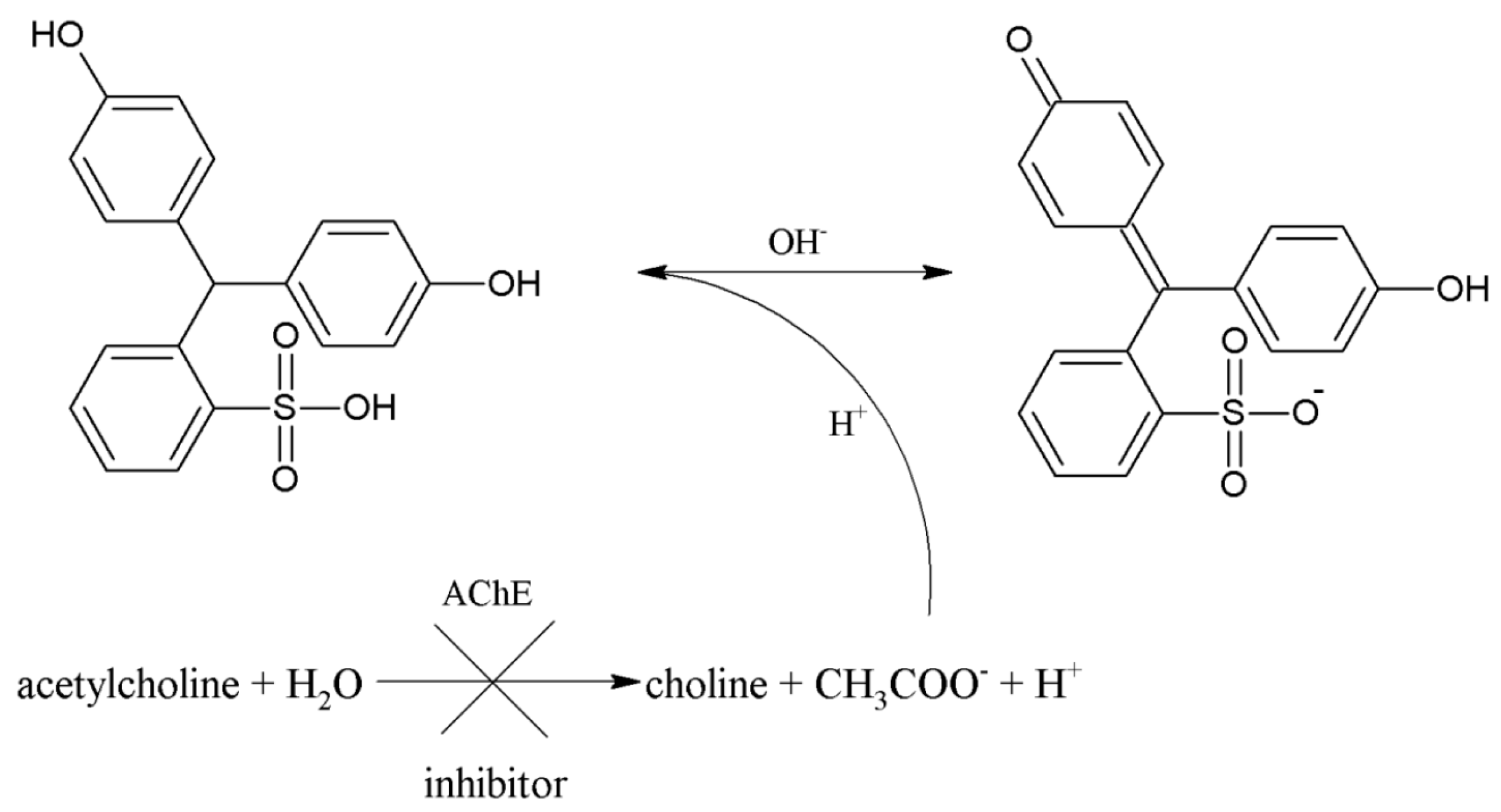

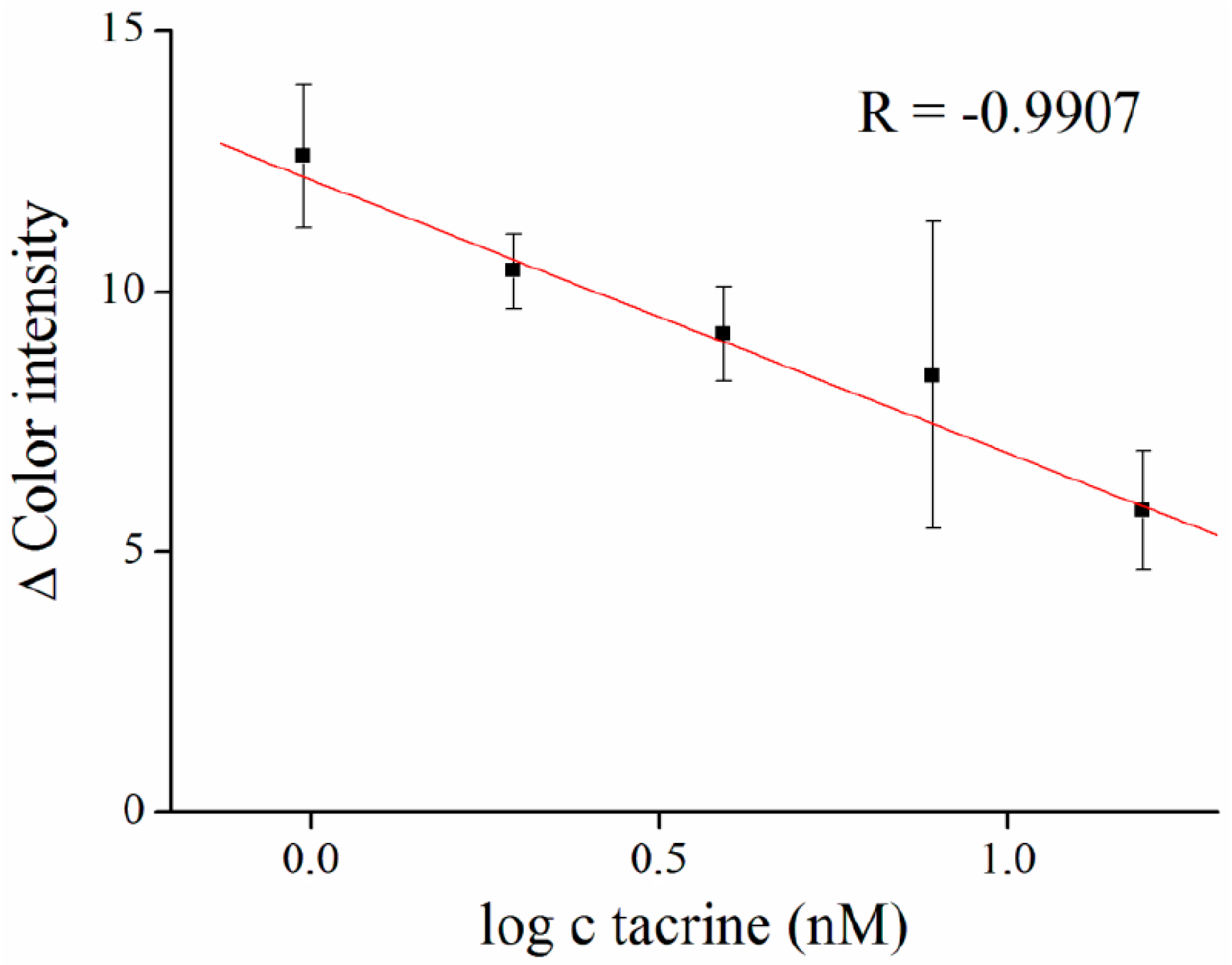

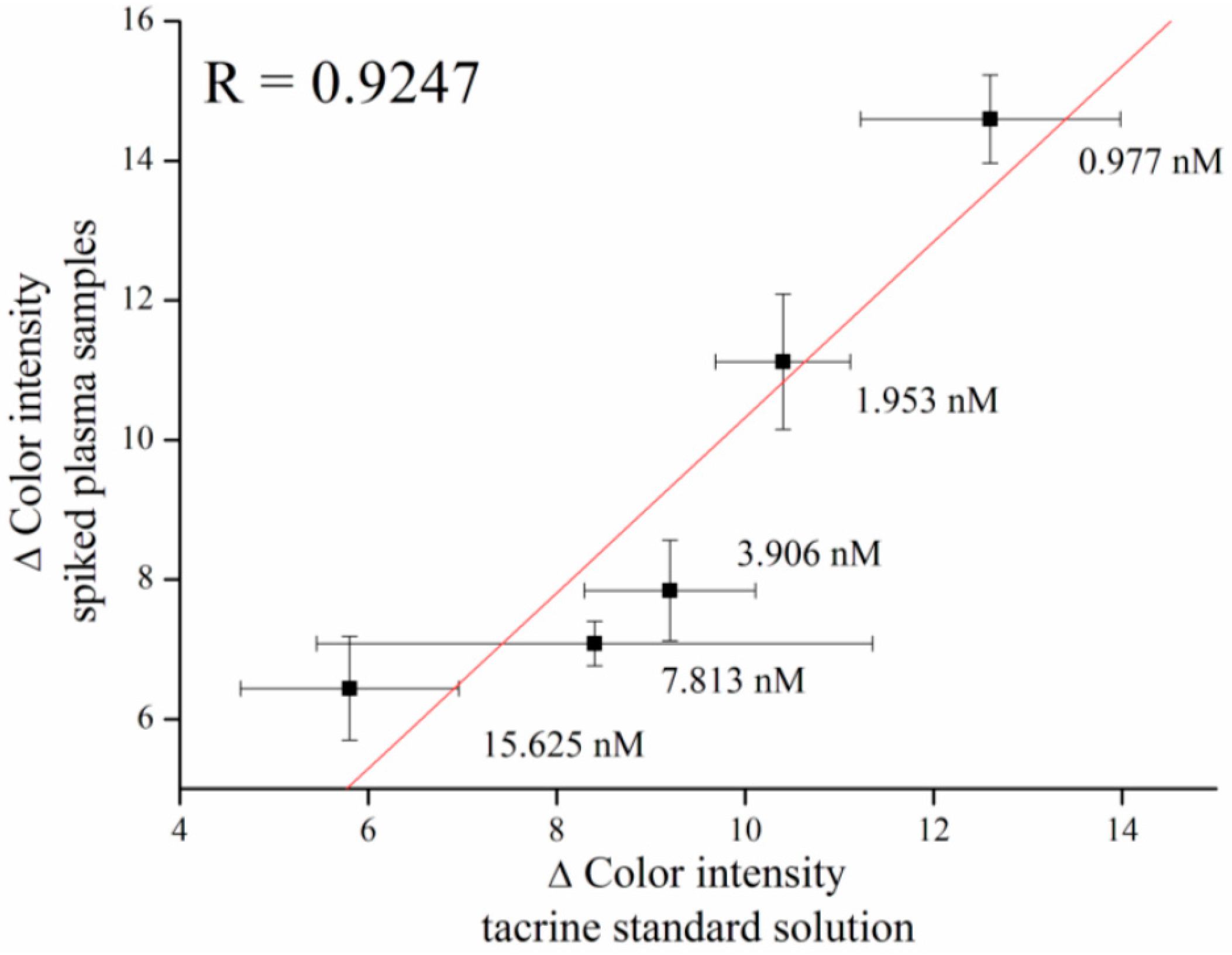
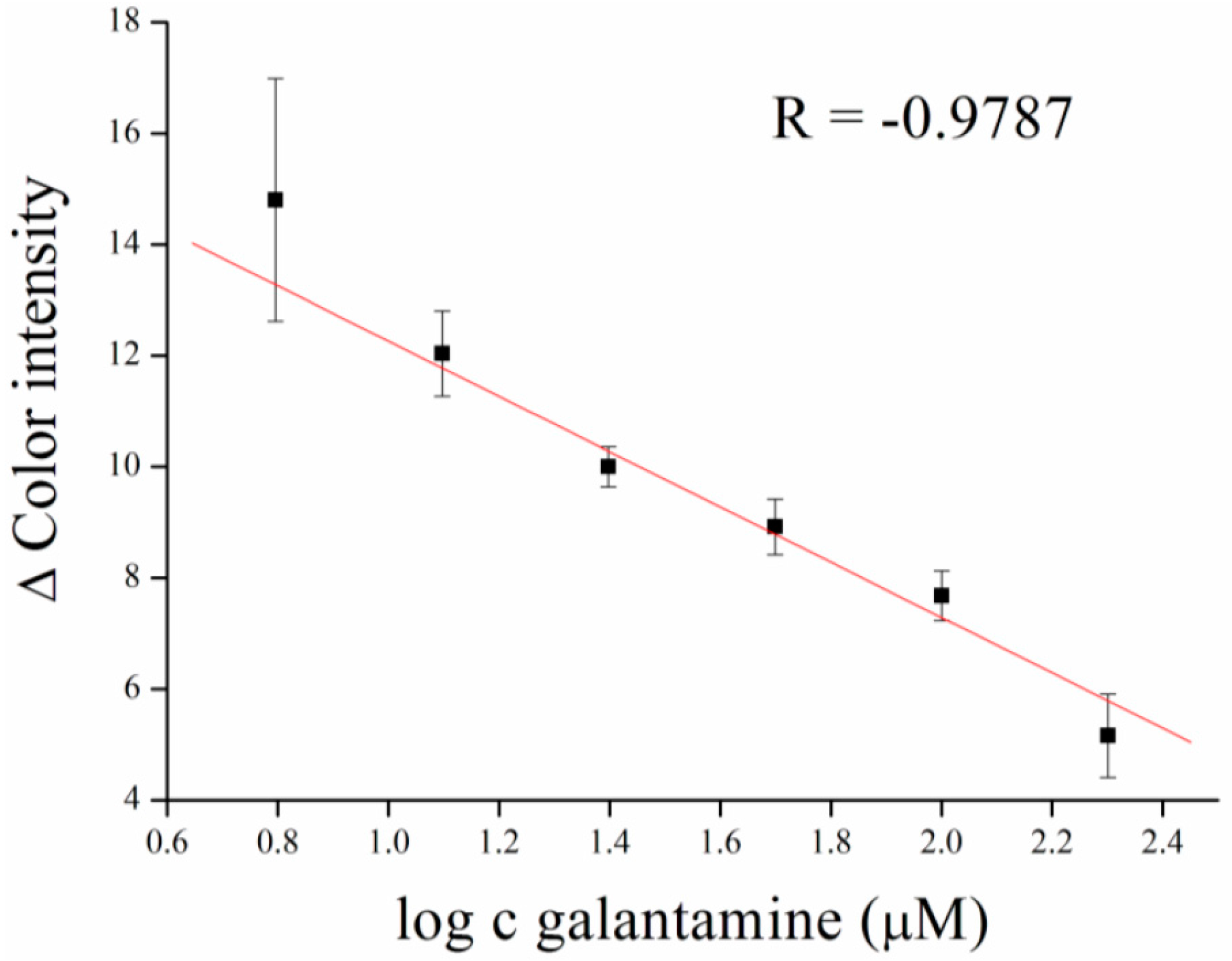
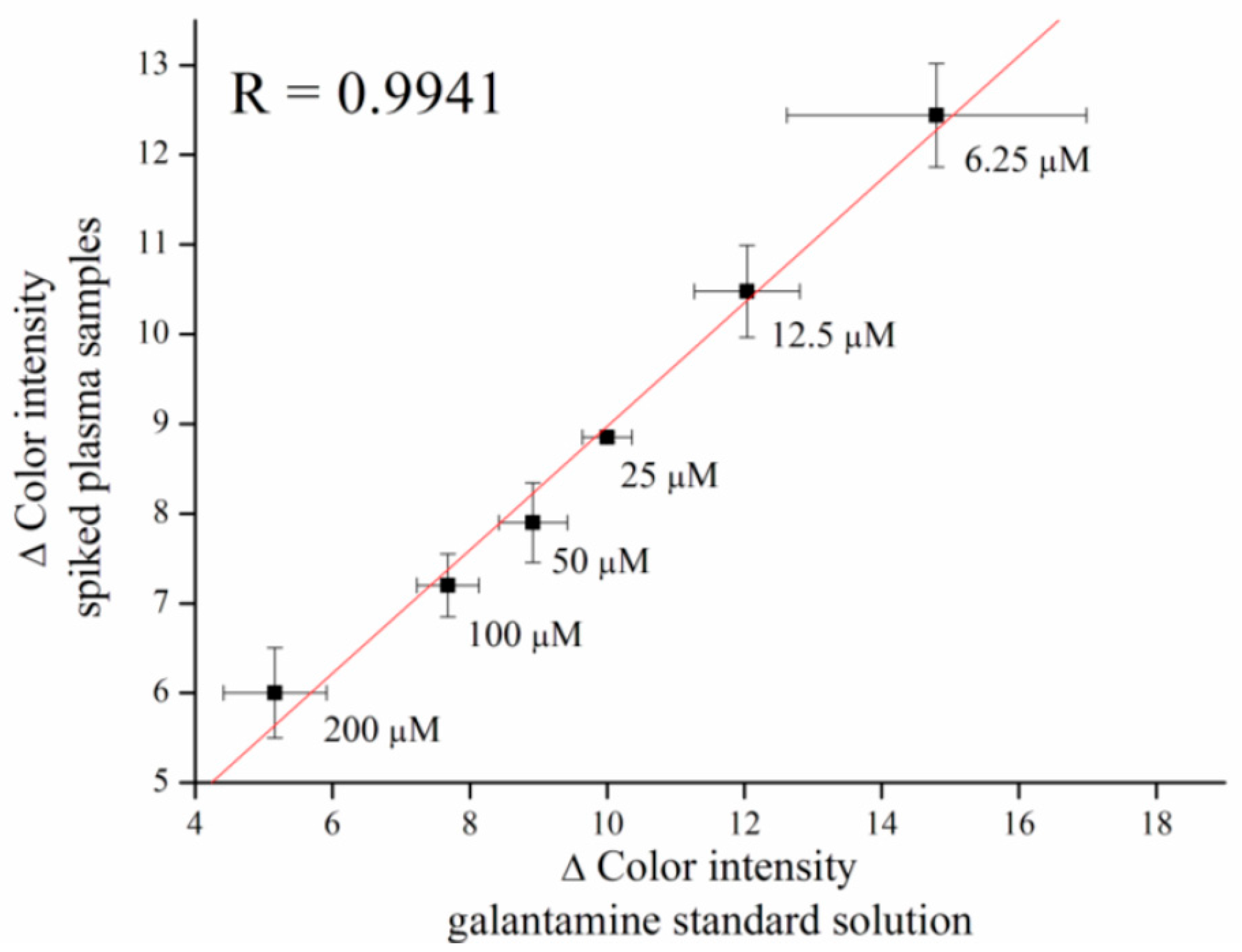

| LOD Achieved | Fabrication Time | Assay Time | Necessary Equipment | Possibility to Check the Assay by a Naked Eye | Determination of Analyte Exact Concentration | |
|---|---|---|---|---|---|---|
| Presented camera based assay | Tacrine: 1.1 nM Galantamine: 1.28 µM | 3 h | 10 min | None—only smartphone | Yes | Yes |
| Standard Ellman’s assay like here presented | Tacrine: 1.2 pM Galantamine: 18.3 nM | NA | 10 min | Spectrophotometer | Yes | Yes |
| Dipstick assay [37] | Neostigmine, paraoxon: both approx 10−7 | Aprox. 1 h | 45 min | None | Yes | No |
| Colorimetric assay [33] | Tacrine: 10 nM | Aprox. 1 h | 45 min | None | Yes | No |
| Flow fluorimetric assay [38] | Galantamine: 0.5 µM | NA | 10 min | Fluorimeter, pumps, reaction coil | No | Yes |
© 2016 by the authors; licensee MDPI, Basel, Switzerland. This article is an open access article distributed under the terms and conditions of the Creative Commons Attribution (CC-BY) license (http://creativecommons.org/licenses/by/4.0/).
Share and Cite
Kostelnik, A.; Cegan, A.; Pohanka, M. Color Change of Phenol Red by Integrated Smart Phone Camera as a Tool for the Determination of Neurotoxic Compounds. Sensors 2016, 16, 1212. https://doi.org/10.3390/s16091212
Kostelnik A, Cegan A, Pohanka M. Color Change of Phenol Red by Integrated Smart Phone Camera as a Tool for the Determination of Neurotoxic Compounds. Sensors. 2016; 16(9):1212. https://doi.org/10.3390/s16091212
Chicago/Turabian StyleKostelnik, Adam, Alexander Cegan, and Miroslav Pohanka. 2016. "Color Change of Phenol Red by Integrated Smart Phone Camera as a Tool for the Determination of Neurotoxic Compounds" Sensors 16, no. 9: 1212. https://doi.org/10.3390/s16091212








